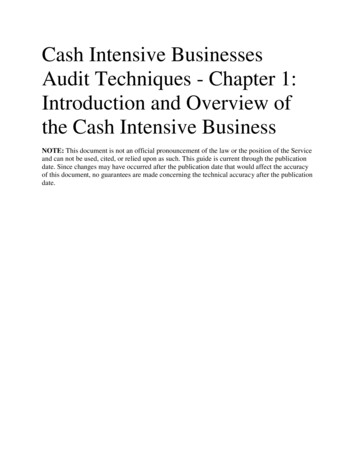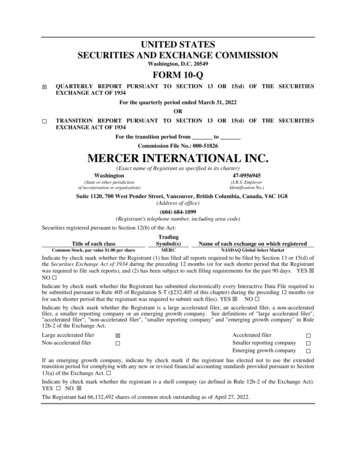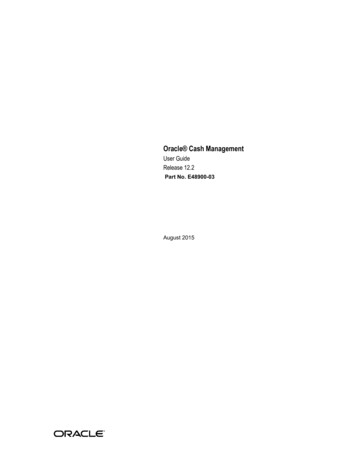
Transcription
Cash Intensive BusinessesAudit Techniques - Chapter 1:Introduction and Overview ofthe Cash Intensive BusinessNOTE: This document is not an official pronouncement of the law or the position of the Serviceand can not be used, cited, or relied upon as such. This guide is current through the publicationdate. Since changes may have occurred after the publication date that would affect the accuracyof this document, no guarantees are made concerning the technical accuracy after the publicationdate.
ContentsStatement of Purpose . 2Introduction and Overview of the Guide . 2Respecting the Taxpayer's Privacy . 4Definition of a Cash Intensive Business . 4Using a Cash Register . 5Businesses Without a Cash Register . 6Books and Records . 7Page 1 of 8
Statement of PurposeThe purpose of this audit techniques guide (ATG) is to provide guidance for the examination ofincome in a cash intensive business. This guide can be used during all phases of the examination.This ATG will: Provide background about Cash Intensive BusinessesIdentify frequent and/or unique issuesProvide examination techniquesSupply applicable laws and court casesThis guide is not designed to be all-inclusiveThe use of Indirect Methods, also referred to as the Financial Status Audit Techniques (FSAT),is not prohibited. However, examiners must first establish a likeliness of underreported orunreported income. Examiners must then request an explanation of the discrepancy from thetaxpayer. If the taxpayer cannot explain, refuses to explain, or cannot fully explain thediscrepancy, a FSAT may be necessary. Remember that just being a Cash Intensive Business(CIB) does not automatically allow the use of an FSAT.Introduction and Overview of the GuideThe accurate reporting of income and expenses by cash intensive businesses has been the subjectof various studies by the Service, as well as General Accounting Office (GAO). The GAOestimates that the individual income tax "gap" is in the hundreds of billion of dollars. Thecommon theme of these studies is that there has been, for those taxpayers with the ability todetermine their own reported income, an increasing underreporting of income.Of particular interest are businesses and individuals who receive most of their income in cash.Cash transactions are anonymous, leaving no trail to connect the purchaser to the seller, whichmay lead some individuals to believe that cash receipts can be unreported and escape detection.There are three main ways to misappropriate cash from a business. It can be skimmed from receipts, for example, pocketed before it is recorded. If thishappens it will not be discovered by auditing the books.It can be stolen after it has been recorded, for example, cash removed from the cashregister or goods stolen from the shelf for future resale.A fraudulent disbursement can be created, for example, a payment to a vendor that isactually cashed by the owner’s son.The most significant indicator that income has been underreported is a consistent pattern oflosses or low profit percentages that seem insufficient to sustain the business or its owners. Otherindicators of unreported income include:Page 2 of 8
A life style or cost of living that can’t be supported by the income reported.A business that continues to operate despite losses year after year, with no apparentsolution to correct the situation.A Cash T shows a deficit of funds.Bank balances, debit card balances and liquid investments increase annually despitereporting of low net profits or losses.Accumulated assets increase even though the reported net profits are low or a loss.Debt balances decrease, remain relatively low or don’t increase, but low profits or lossesare reported.A significant difference between the taxpayer’s gross profit margin and that of theirindustry.Unusually low annual sales for the type of business.Auditing cash businesses is both a science and an art. Tax law, accounting and the process ofreporting income are sciences. These require specific knowledge and are concrete and tangible.These can all be verified. The art comes from the examiner’s own creativity in developing amethod to determine that all income is properly included. For this the examiner must use theirindividual style and flexibility to modify the examination process as needed for each particularcase.If an examiner wants to find income, they must actively look for income. Unlike examiningexpenses, which can either be verified or not, hidden income is harder to find and requires aproactive approach. Examination techniques must be tailored to provide for the best analysis of aspecific taxpayer's possible income stream.There are several techniques that can be used successfully when working with cash intensivebusinesses. First, a financial status analysis including both business and personal financialactivities should be done. This is a required minimum income probe. If it shows an imbalance inthe cash flows indicative of underreported income, request clarification or explanation from thetaxpayer before beginning the use of an Indirect Method (Financial Status Audit Techniques).Indirect methods, such as a fully developed Cash T, percentage mark-up, source and applicationof funds or bank deposit and cash expenditures analysis,, can then be used to confirm the amountof any understatement. Seek your Area Counsel’s opinion regarding the use of non-conventionaltechniques prior to initiating any action.The fact that the cash intensive business may have substantial lack of internal control is not themain question. The methodology used by the taxpayer may be correct and the income reportedproperly. The most critical aspects to successfully examining a cash intensive businesses is theexaminer's ability and skill in gathering information about how the taxpayer conducts business,documenting cash inflows and outflows, and conducting a detailed interview with the owner ofthe business relating to business and non-business cash receipts and cash expenditures.IRM 4.10.4.6.1 addressed the requirements for Examining Income and Using Financial StatusAudit Techniques (FSATs). It discusses the prohibition of the use of Financial Status AuditTechniques to determine the existence of unreported income unless a reasonable indication thatPage 3 of 8
there is a likelihood of unreported income has been established. A reasonable likelihood can beestablished with the initial unresolved financial status analysis (T account).The examination of income is a mandatory audit issue. Examiners must determine whether thetaxpayer reported the correct amount of income. The depth of the examination of income and thetechniques used are dependent on the facts and circumstances of the case. Generally,consideration should be given to tax return information, the reliability of the taxpayer's booksand records, the outcome of the Minimum Income Probes, and the resolution of LUQ (Large,Unusual, Questionable) income issues.The use of other audit technique guides and technical support by Area facilitators will generallyprovide a higher degree of consistency in treatment of issues and taxpayers. Additionally,Headquarters facilitators can provide support for their respective market segments, asappropriate.Respecting the Taxpayer's PrivacyIn-depth examinations of income may involve a thorough examination of the taxpayer's booksand records or contacting third parties. Examiners should be sensitive to the burden this placeson the taxpayer and the impact an in-depth examination may have upon the taxpayer's personaland professional life.Ask only for information relevant to and necessary for resolving the issue. Ask the taxpayer toprovide the information needed; information should be collected directly from the taxpayerwhenever possible. Contacting third parties for information is intrusive and should only be doneif the taxpayer is unable or unwilling to provide the information. If a third party must becontacted, ask yourself whether the information is really needed, if there is a less intrusivealternative way to get the information, and be sure that the taxpayer's confidentiality is notbreached. If possible, verify information obtained from third parties with the taxpayer beforereaching a conclusion or proposing an adjustment based on the third party information.Respect the taxpayer's right to representation. Examiners cannot require that a taxpayerparticipate in the audit or be interviewed without a summons. However, examiners need to talkwith a knowledgeable person. The taxpayer's voluntary presence at an interview, or tour of thebusiness site, can be requested through the representative. If the representative is notknowledgeable and information from the taxpayer is needed, consider summonsing the taxpayerto appear and answer questions. Make every effort to ask all pertinent questions during theinterview if the taxpayer is summonsed, because it may be difficult to secure a second meeting.Keep managers informed. Alert managers if a required Minimum Income Probe indicates amaterial imbalance and discuss how the issue will be developed. Managerial involvement andsupport is important and should be documented in the case.Definition of a Cash Intensive BusinessPage 4 of 8
A cash intensive business is one that receives a significant amount of receipts in cash. This canbe a business such as a restaurant, grocery or convenience store, that handles a high volume ofsmall dollar transactions. It can also be an industry that practices cash payments for services,such as construction or trucking, where independent contract workers are generally paid in cash.Using a Cash RegisterA business with a large number of cash transactions probably uses a cash register. Sales areentered into the register, using different keys for different sales. This is done so the owner candetermine the cost of sales in each product area, for example, beer sales, dairy sales, soda sales,grocery sales, etc. A product line that is not profitable will soon be refined or eliminated, becausethese stores are usually small and every inch of space must be productive.Each cash register drawer begins with an amount of money to be used as change. Whether theoperation is a small business, a large restaurant or a major retail store, the drawer will only beginwith a minimum amount of currency, about 150 to 250.The workers will ring up every sale on the cash register and provide a cash register tape receiptto each customer. If cash is taken out of the register for small purchases, to cash checks, or forthe owners use, a note is made and is retained in the drawer.The cash register will produce a detail tape locked in the register, which is a continuous record ofeach transaction recorded that day, with a total (X total). This tape will identify the type ofpurchases keyed into the register, for example, grocery, liquor, coupons, etc., and what type ofpayment was received, for example, cash, check, etc.The cash register will also provide, under a separate key control, the accumulated total amount ofsales (Z total) that is carried forward for a longer time period, until authorized to be reset at zero.The detail tape (X total) should not be accessible to the person using the register, and the resetkey (Z total) should only be accessible to senior management. In a small proprietorship orclosely held business this control may be impossible.At the close of the business day, the supervisor will unlock the register and read the X total. Thesupervisor then clears the cash register for the following day, thus automatically recording on theZ tape the transaction total (X total) of the current day's cash receipts. The detail tape (X total)should then be removed from the register and retained for subsequent comparison with the totalcash turned in from the register.Sales from the cash register are totaled at least daily, usually at the end of a worker’s shift. Theemployee will count the cash in the drawer, less the beginning balance which is retained in thedrawer for the next shift’s use. The worker may count the cash while a supervisor is present ormay count the cash and enclose it in an envelope for deposit in the business safe. The workerwill also total the checks and credit card payments received.Page 5 of 8
A designated person will open the envelopes containing the shift cash, count total cash andprepare deposit slips. A copy is made of the deposit slip and retained by the designated person.The supervisor, or another individual, will take the cash to the bank, returning with the depositreceipt, which is matched to the copy of the deposit slip. This is an important internal controlthe same person must not prepare the deposit and take the cash to the bank.The supervisor will determine sales for the day (or shift) by printing the Z tape total on theregister. The Z tape records the total transactions, such as sales by type, the number of customersand the number of items rung in for the period. This is another important internal control- thesame person does not count the cash and total the sales, otherwise, all overages could go into thepocket of the counter.The total sales for the period are reconciled by comparing sales recorded on the Z tape to theincome in the drawer (cash, checks, credit card purchases and cash paid out). All differencesbetween receipts and the cash register tapes must be reconciled and a record kept of cashoverages and shortages.Once this important reconciliation is complete, the total sales for the day or period can be enteredon a daily sheet. The cash register Z tape and all reconciliations, discrepancies and notes areretained and attached to the daily sheet.The total daily sales amount (from the daily sheet containing all reconciliations) is entered on asales sheet that generally records all sales for the month. This is usually the document that goesto the bookkeeper to record monthly sales. The daily detail tapes (X totals) are source documentsthat must be retained by the business.The sales made by check and credit card can be subtracted from the total sales for any period todetermine the amount of cash received. This can be compared to cash deposited to the bank.Businesses Without a Cash RegisterBusinesses that have fewer transactions will usually issue sales invoices or receipts to eachcustomer, rather than use a cash register.At the end of each work day, the worker may count the cash received while a supervisor ispresent or may count the cash and enclose it in an envelope for deposit in the business safe. Theworker will also total the checks and credit card payments received. These will be entered on adaily sheet.A designated person will open the envelopes containing the shift cash, count total cash andprepare deposit slips. A copy is made of the deposit slip and retained by the designated person.The supervisor, or another individual, will take the cash to the bank, returning with the depositreceipt, which is matched to the copy of the deposit slip. This is an important internal control forthe protection of cash reporting- the same person must not prepare the deposit and take the cashto the bank.Page 6 of 8
The supervisor, or designated individual, will total sales invoices for comparison with the cashcollected (plus cash paid out). If there is any discrepancy between sales invoices and paymentsreceived, a reconciliation must be made and notes are retained with the daily sheet. This isanother important internal control- the same person does not count the cash and total the sales. Agood indication of whether this happens is whether overages are shown. If cash shortages appearperiodically, but cash overages are never recorded, that is a good indication this internal controlis missing: the same person reconciles cash and sales.The business will record each individual receipt separately in the sales journal, retaining theinvoices, reconciliations and deposit slips as back-up documents.Books and RecordsEvery business has its own procedures and internal forms. The procedures and forms, at aminimum, must document the flow of each receipt or revenue from the customer’s hands to thebusiness, to the final end in the business bank account or as payment for a business expense.The examiner can expect to see the summary Z tapes and the detail X tapes (if a cash register isused), sales invoices or receipts (if no cash register is used), daily reconciliation sheets, monthlysales sheets (that will match the Statement of Profits and Losses) and bank deposit detail. Anydeviation from these elementary steps should be recorded by the examiner and may indicate adisregard for recordkeeping rules and a lack of internal controls.The books and records of a cash intensive business may not be kept in any particular industrystandardized format. When these entities are small businesses or the taxpayers are notsophisticated with respect to record keeping or the tax law, the only way to understand thebookkeeping system is to have the taxpayer explain it.If the taxpayer has a representative, the examiner may have to walk through the taxpayer’s bookswith the taxpayer to the point at which they submit their figures to the representative. The samewalk through with the representative will then be conducted in order to determine the audit trailfrom the source documents, through the original books of entry, to the tax return/taxreconciliation workpapers.Page 7 of 8
proactive approach. Examination techniques must be tailored to provide for the best analysis of a specific taxpayer's possible income stream. There are several techniques that can be used successfully when working with cash intensive businesses. First, a financial status analysis including both business and personal financial










